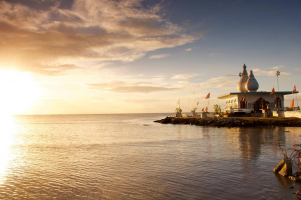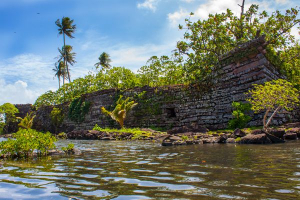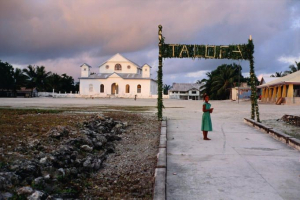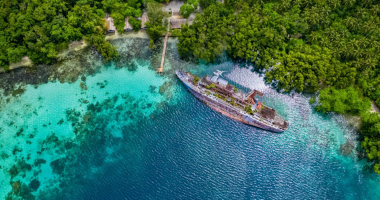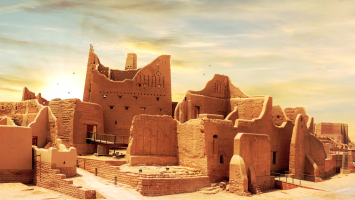Top 10 Most Beautiful Historical Sites in Guernsey
Guernsey is full of recent history and the island was the closest place to mainland Britain to be occupied by the Germans during World War 2. Occupied by ... read more...Germany during World War 2 there are many concrete bunkers and deep tunnels holding Guernsey’s history. The German underground military hospital holds an eeriness to it however Toplist would say these are definitely worth a visit as the most beautiful historical sites in Guernsey.
-
The La Vallette Underground Military Museum is an excellent venue to learn about Guernsey's military history, particularly World War I and World War II's German Occupation, and is one of the most beautiful historical sites in Guernsey. This museum is similarly concealed underground in one of the island's German-built tunnels, and if it weren't for the entrance, it would be nearly undetectable from the surface. This underground passage was utilized by the German army to store their U-boats and gasoline. The tunnels were converted into a museum in late 1987, and it took two years to complete.
Allied Forces planned to destroy all long-range radar equipment in the vicinity of northern France in late May 1944, in preparation for the invasion of France. The Freya radar station, which was located near this museum at Fort George, was particularly important because it covered the area to the west of the Normandy beaches. The RAF launched two attacks to disable the radar. There were numerous casualties, as well as the loss of eight Allied aircraft. Due to their substantial fortification, the Allied Forces decided to skip the Islands during the D-Day Landings.
Today, the museum houses a large collection of historical artifacts, as well as mementos and exhibits from the German occupation. The town terminus bus stop is within walking distance of the Underground Military Museum. If you're feeling bold, head across the road to the La Vallette Bathing Pools, which are perfect for a refreshing plunge in the sea while taking in the spectacular views of Castle Cornet. A broad variety of genuine military collectibles and literature are available for purchase by museum visitors.

Tripadvisor 
Liberation Route Europe -
At the mouth of St. Peter Port harbor is the Castle Cornet Museum, an 800-year-old castle. The castle, located just a short walk from the town center, provides a fascinating glimpse into the island's history as well as excellent panoramic views back towards St. Peter Port and out across our sister islands. It is much larger than it appears at first glance, so plan on spending at least three hours there.
The four museums situated within the castle tell the story of the castle and various aspects of Guernsey's past. The Story of Castle Cornet, the 201 Squadron (RAF) Museum, the Royal Guernsey Light Infantry Museum, and the Royal Guernsey Militia Museum are among the attractions. Outside the castle walls, there is plenty to see and do, including four historic gardens: Governor's Garden, Sutler's Garden, Lambert's Garden, and the Master Gunner's Garden, as well as plenty of space to find a private location for quiet thought even on the busiest of days.
The construction of the fortress was necessitated by King John's loss of Normandy in 1204, which necessitated improved defenses for the Channel Islands. The castle was originally located on a small island off the coast of Guernsey that could only be reached by foot at low tide. Access to the castle was eventually allowed by bridges and harbor walls as the island's population grew and the harbor of St Peter Port stretched out to sea.

My First 100 Countries 
BailiWick Express -
The Vale Castle is located on the north side of the island, just a short walk from the Bordeaux kiosk. Guernsey Vale Castle is a fantastic site for dawn and sunset in Guernsey, as it overlooks the northeast part of the island with amazing views out towards Herm and Sark. Because it is available to the public all year, there are no set opening hours for early mornings or late nights, making it ideal for photography; you may go there anytime you want.
The site of the castle is said to date back to the Iron Age, but the stone structure that you see now comes from the 15th century. During WWII, the castle was also utilized by occupying forces, and relics of this may still be seen today. Vale Castle's sunset panorama, which can be seen from the top of the castle, combines the island's ancient past with its modern-day charm. As you look beyond the fortification's weathered stones, you'll see the skyline of St Sampsons, complete with the local power plant's tall chimneys.

Flickr 
Guernsey with Kids -
Fort Pezeries is near the 'Fairy Ring' at Torteval, on Guernsey's South-West Coast, and has been a fort since at least 1680! The fort is interesting to tour since three 18-pounder cannons are still on the premises, and the 360-degree views from there are breathtaking. Fort Pezeries is in Pleinmont, and unlike the other forts on the island, there is no parking nearby, so plan on walking. Parking is available at the Pleinmont Observation Tower or Portelet Harbour. Don't be scared off by the distance; the walk from Portelet Harbour is popular with families and one of our favorites because it includes a beach, a German bunker, trees to climb, a meeting place for fairies, and the most stunning scenery in all directions!
Portelet is the starting point for the walk. Portelet is located at the end of the coast road between Cobo and Vazon, near The Imperial Hotel. Beyond the hotel, there is plenty of parking. Follow the tarmacked road that runs behind Portelet Beach; it's not a cliff walk trail, but rather a proper wide, tarmacked road (with no cars). It's extremely easy to walk on, and it's ideal for pushing a pram or wheelchair. Even on a windy, dismal day, the views back to Rocquaine Bay and the Cup and Saucer (Fort Grey) are stunning, thanks to an old stone wall that runs the length of the trail.

Mapio.net 
Mapio.net -
Ivy Castle, also known as Chateau des Marais, is a castle on Le Grand Bouet, on the island's north shore, and is one of the most beautiful historical sites in Guernsey. The Chateau des Marais, built in the 13th century, was utilized as a pirate hideaway. Prior to the construction of Castle Cornet in 1250, the castle served as Guernsey's primary defensive structure for 20–30 years. The Chateau des Marais was originally built as a motte-and-bailey castle, with stone walls and a raised section of ground known as a motte. This was a typical castle construction during that time.
During World War II, the Germans repurposed the Chateau des Marais, destroying the archaeological traces of the motte-and-bailey structure by constructing a bunker, machine-gun installations, and communication trenches. The Chateau des Marais was passed to the States of Guernsey by the War Department and Her Majesty's Commissioners of Crown Lands throughout the twentieth century. Restoration work on the castle was completed in the 1970s, and it is now managed by the Guernsey Museums Service.

Mapio.net 
Raving Loony Productions -
The Batterie Dollman Gun Pit, located on Pleinmont Headland, is a rebuilt battery gun pit that houses the last of its kind in Europe and is one of the most beautiful historical sites in Guernsey. Guernsey Armouries rebuilt the French gun, which weighs 10 tonnes and measures 22 cm, in 1997. One of three German Coastal Artillery Batteries is stationed in pit number three. Before work on rebuilding the gun pit could begin, an estimated 1,000 tons of soil had to be removed, most of which was done with an excavator, but several tons had to be shoveled out by hand.
The Batterie Dollman is still being thoroughly repaired, with every effort made to make it look as authentic as it did during WWII. When the restoration work first started, the bunkers appeared to be in excellent condition, with guarded doors and even a bunker telephone remaining in situ. During the summer, the site is open to the public on Sundays, and the cannon is shot with blank charges.

Facebook 
Visit Guernsey -
Fort Le Marchant, which was built in the 17th century and is located off the northern shore of Guernsey, has long served as a deterrent to foreign invaders. Since around 1680, there has been a fort of some kind on the site of Fort Le Marchant in Vale. The original stronghold, known as Fort L'Angle, was expanded at the end of the 18th century when fears of a French invasion prompted the construction of new fortifications all along Guernsey's coast.
The new fort was named after the then Lieutenant Bailiff, Eleazar Le Marchant when it was finished in 1805. On the landward side of the fort, a massive barracks was built in 1854, surrounded by a defensive ditch. Since then, the barracks have been dismantled, and the ditch has been filled in.
A second barracks was built on the site of Fort le Marchant in 1854, but it has since been dismantled, in addition to the fortifications that can still be seen today. At high or low tide, Fort le Marchant is a lovely site to visit for a walk along the shore. It is fairly common to see dogs off the leash in this location, which is very popular with dog walkers, so be mindful when driving into the neighborhood.

Guernsey with Kids 
Guernsey with Kids -
Fort Hommet Headland is a Victorian fortress on the Vazon Bay headland that includes a Martello tower as well as bunkers and casemates built by German forces during WWII. With two storeys and magnificent views across the water, this is a terrific spot to explore. In Vazon, off Rue d'Albecq, is Fort Hommet. Keep an eye out for the brown sign indicating a path off the coast road that leads to a parking lot at the end.
Fort Hommet is also easily accessible from Vazon Beach. Parking is available behind the beach, adjacent to Vistas Cafe, with a walkway leading to the fort on the right side of the parking lot. When you reach a parking area a little distance along the pathway, cross it and look to your left for some steps that will lead you to another footpath that leads to the fort. There are a few picnic chairs just past the top of the steps, which are an excellent site for a picnic because of the beautiful view across Vazon Bay.
The fort is a fascinating place to visit. However, by 1795, the fort had been strengthened and new gun positions were built. The headland had 6 guns in 1801 and the Martello tower was constructed in 1804. A barrack block was built in 1856 and held a portion of the Regular Army garrison until the First World War when it was demolished. In 1942, the occupying German army expanded to the fort, which can still be seen today.

Guernsey with Kids 
Visit Guernsey -
With a height of 75,000 feet, the German Underground Hospital and Bunker is the tallest WWII building in the Channel Islands and is one of the most beautiful historical sites in Guernsey. Except for the massive concrete entryway, the maze of tunnels beneath ground level would be utterly undiscovered. This underground complex was originally constructed as a shelter for a machine gun business, not as a hospital. The choice and transformation of making the tunnels into the Underground Hospital didn't happen until 1944. This is an interesting destination to see when in Guernsey, but even on a hot summer day, the tunnels are freezing, so bring some warm clothing.
Guernsey's history is fascinating, and if you plan on seeing many of the sites, you might as well invest in a Discovery pass. This is an annual pass that allows you to visit Castle Cornet, the Guernsey Museum and Art Gallery, Fort Grey, and the German Naval Signals Headquarters at any time throughout the year. On your vacation to Guernsey, make sure to stop by the German Underground Hospital. Here you may learn about Guernsey's German occupation and examine some of the ancient equipment that was utilized here during the war.

Explore Guernsey 
Wikimedia Commons -
Clarence Battery was established in the late 1780s as one of the original outside defenses of Fort George, Guernsey's principal military headquarters. It was initially known as "Terres Point Battery" but in 1805 it was renamed "Clarence Battery," after George III's son.
The artillery is in good condition, with various defenses and substantial walls that would have provided considerable protection if the area had been attacked. Its elevation location provides a spectacular view of St Peter Port and Castle Cornet, as well as the Castle Breakwater. The location was obvious for a defensive construction, so it's no surprise that it was built during the height of the French Revolution and that it was used by the German occupying forces as the site of the Luftwaffe's early warning system during WWII.
During the French Revolution, it served as the island's main fort, and during World War II, it housed the German Luftwaffe's early warning system. A guard room, cannon pivots, ammo lockers, shell stories, and artillery stores were all part of the battery. Minor of it has survived, however, the Germans made some changes during their occupancy.
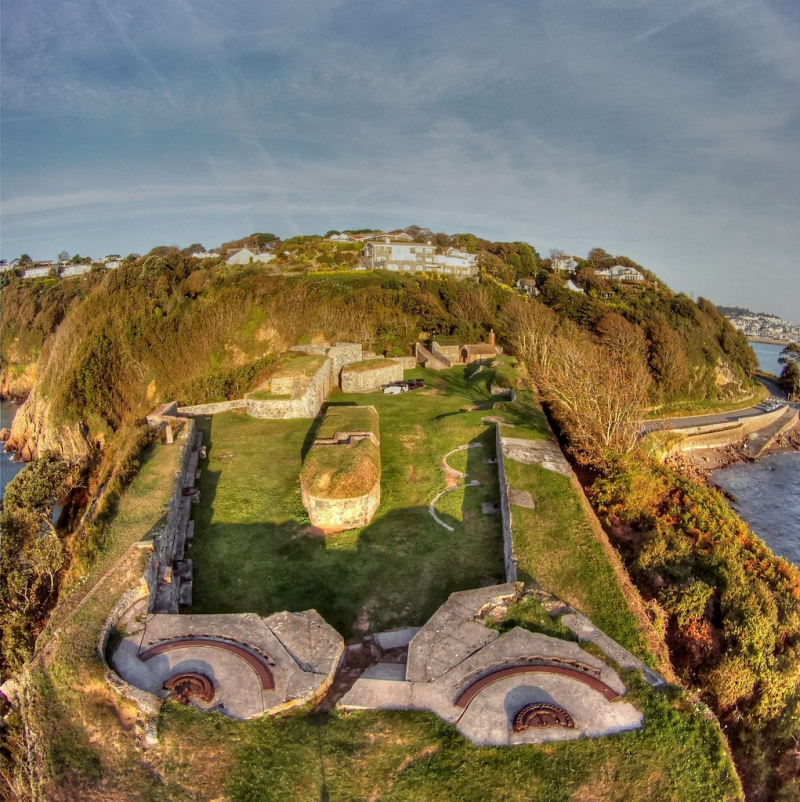
Flickr 
Wikicommons













